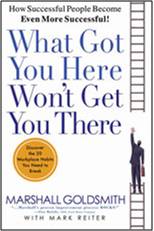
Behavioral Change / Leadership Development
Questions for Creating Lasting Postive Behavioral Change
Questions contributed by Dr. Marshall Goldsmith on Dec. 5, 2009. The following interview is based on Dr. Goldsmith's New York Times Best Selling Book: What Got You Here Won't Get You There.
QFL: What were the primary questions that attracted you to executive coaching?
Goldsmith: How can I help leaders achieve positive lasting change in behavior?
I got into coaching after realizing that leadership development helped some leaders but many leaders who attended programs didn't change at all. My partner Howard Morgan and I did research that documented the impact of follow up. This research helped me understand that ongoing interaction with leaders can dramatically increase the probability that they will achieve positive lasting change.
QFL: What are the primary questions, that you have asked yourself over the years, which have most contributed to your success as an executive coach?
Goldsmith: How can I help my clients achieve positive lasting change in the behavior that is most important, as judged by the stakeholders that are most important?
As I've grown older, I've realize more and more that the motivation for change needs to come from inside my clients not than from inside me. My job is to help them achieve positive lasting change in the behaviors they choose as judged by the people they choose. If it does not come from inside them it either: 1) won't happen, or 2) if it does appear to happen, it will be false or phony and will not last.
QFL: What are the primary questions that you asked yourself when developing What Got You Here Won't Get You There?
Goldsmith: There are three primary questions:
1) What are the classic challenges that come with success?
I had the privilege of working for over 50 days with Peter Drucker. I was on the board of the Peter Drucker foundation for 10 years. Peter Drucker said, "We spend a lot of time teaching leaders what to do, we do not spend enough time teaching leaders what to stop. Half of the leaders I meet do not need to learn what do, they need to learn what to stop." His comment led to a large part of What Got You Here Won't Get You There.
2) What are the most important behaviors that successful leaders need to stop?
In building upon Peter Drucker's comment, I analyzed my own experience with successful leaders, read research of studies about the characteristics associated with success, and began to develop a list of the most common behaviors that leaders need to stop.
3) After determining what to change, how can leaders develop a systematic process to ensure that positive change actually occurs?
Successful leaders are busy. I realized that in order to help them achieve positive lasting change, I would need to develop a disciplined process that they could follow in the middle of a busy and hectic schedule.
QFL: What questions do you ask your clients to help them achieve positive and lasting behavioral change?
Goldsmith: I start by asking the client the same questions that I ask the client’s key stakeholders, specifically:
1) What are you doing well?
2) What do you need to change?
3) If you were the coach or advisor for yourself what advice might you have for you, ranging from broad strategic advice to narrow tactical advice?
I ask these questions before I ask the same questions to my client's key stakeholders so that I can make a comparison of their self perception with the perception of everyone around them.
QFL: What questions do you ask your client’s stakeholders, to help your client achieve positive and lasting behavioral change?
Goldsmith: When I interview my client's stakeholders, I ask the same following three questions:
1) What is my client doing well?
2) What does my client need to change?
3) If you were the coach or advisor to my client what advice would you have for him/her ranging from broad strategic issues to narrow tactical issues?
In a typical interview with my client's stakeholders, each stakeholder will average between 30 and 45 minutes to answer these three questions. The answers to these questions are then summarized and the summary report is then presented to my client.
QFL note: For review, please note the links to Leadership as a Contact Sport & Sample Mini-Survey Report.
QFL: After collecting their initial feedback, what questions do you ask stakeholders to enable them to better help your clients?
Goldsmith: There are four primary questions that I ask stakeholders to enable them to help the clients, specifically:
1) Can you let go of the past?
It is very important that stakeholders focus on what my clients can do better in the future and not fixate on what they've done wrong in the past. I encourage them to give ideas for the future; not feedback about the past. When they talk about we talk with my clients, this process is called "Feed Forward" not "Feedback".
2) Can you be positive and supportive not cynical or sarcastic?
In my coaching process, my clients are asked to reach out to their key stakeholders. If the key stakeholders are sarcastic or cynical my clients tend to give up; if the stakeholders are positive and supportive my clients tend to continue.
3) Can you please tell the truth?
I am not naive. I realize that just because people say they will tell the truth, they may not. I also know that when people say they will tell the truth this declaration increases the odds that they will follow through and tell the truth.
4) Can you please pick something to improve in yourself and discuss this with my client?
When my clients reach out to their key stakeholders, the stakeholders also have a chance to learn from my clients. This two-way dialogue makes the process much more collaborative. In the case study of my favorite client, I was requested to coach one executive; 200 leaders ended up improving themselves. Everyone was focused on helping each other get better as opposed to judging each other.
After my clients reach out to key stakeholders, I asked them:
1. Who did you talk to?
2. What did you learn?
3. And specifically, what are you going to do about it?
These three questions keep my clients focused on the importance of reaching out to key stakeholders, learning from stakeholders, and of translating general learning into specific or action.
QFL: What questions do you ask yourself when working with a client to achieve positive lasting behavioral change?
Goldsmith: The questions I ask myself include:
1) When was the last time you talked to the client?
2) When was the last time that the client talked to each key stakeholder?
3) How can you as a coach help the client translate learning from stakeholders into strategies and actions for change?
These three questions keep me focused on my mission which is to help my clients achieve positive lasting change in the most important behaviors as judged by their most important stakeholders.
QFL: What are the best questions that an individual can ask him or herself to create positive behavioral change?
Goldsmith: I believe the Peter Drucker came up with five questions which best answer this question:
1) What is my mission?
2) Who are my customers?
3) What do my customers consider value?
4) What are my desired results?
5) What is my plan to achieve these results?
These five Peter Drucker questions can help anyone in almost any situation focus in on the most important elements to change.
Marshall's books are available for more infomation:
Dr. Marshall Goldsmith can be contacted at:
Marshall Goldsmith
P.O. Box 9710
Rancho Santa Fe, CA 92067-9710
858-759-0950 Tel
858-759-0550 Fax
Marshall@MarshallGoldsmith.Com
www.MarshallGoldsmithLibrary.com
Marshall Goldsmith
Bio
Dr. Marshall Goldsmith is a world authority in helping successful leaders get even better – by achieving positive, lasting change in behavior: for themselves, their people and their teams. MOJO was released in February 2010. It is a New York Times and Wall Street Journal top ten best-seller - and the Shanghai Daily #1 business book in China. It is already scheduled to be translated into 14 languages.
In November 2009 Dr. Goldsmith was recognized as one of the fifteen most influential business thinkers in the world in the bi-annual study sponsored by The (London) Times and Forbes. The American Management Association named Marshall as one of 50 great thinkers and leaders who have influenced the field of management over the past 80 years. He is one of only two educators who have won the Institute of Management Studies Lifetime Achievement Award. Major business press acknowledgments include: BusinessWeek – most influential practitioners in the history leadership development, Wall Street Journal - top ten executive educators, Forbes - five most-respected executive coaches, Leadership Excellence – top five thinkers on leadership, Economic Times (India) – top CEO coaches of America, Economist (UK) - most credible executive advisors in the new era of business and Fast Company - America’s preeminent executive coach.
Dr. Goldsmith’s Ph.D. is from UCLA. He teaches executive education at Dartmouth’s Tuck School and frequently speaks at leading business schools. He is a Fellow of the National Academy of Human Resources (America’s top HR honor) and his work has been recognized by almost every professional organization in his field. In 2006 Alliant International University honored Marshall by naming their schools of business and organizational studies - the Marshall Goldsmith School of Management.
Marshall is one of a select few advisors who have been asked to work with over 120 major CEOs and their management teams. He served on the Board of the Peter Drucker Foundation for ten years. He has been a volunteer teacher for US Army Generals, Navy Admirals, Girl Scout executives, International and American Red Cross leaders – where he was a National Volunteer of the Year.
Marshall is the million-selling author of many books including: What Got You Here Won’t Get You There – a New York Times best-seller, Wall Street Journal #1 business book, winner of the Harold Longman Award for Business Book of the Year and top ten best-seller in seven major countries; Succession: Are You Ready? – a WSJ best-seller; The Leader of the Future -a BusinessWeek best-seller, The Organization of the Future 2 - Choice Award (top academic business books) 2009; and Coaching for Leadership. Over three hundred of his articles, interviews, columns and videos are available for viewing and sharing online (for no charge) at www.MarshallGoldsmithLibrary.com. Visitors to this site have come from 195 countries and have viewed, read, listened to, downloaded or shared resources over 4.4 million times. He has regular blogs at www.HBR.org, www.BusinessWeek.com and www.HuffingtonPost.com.



